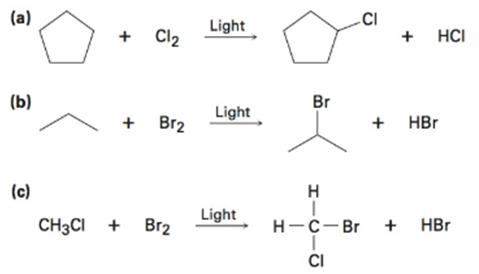
Organic Chemistry
9th Edition
ISBN: 9781305080485
Author: John E. McMurry
Publisher: Cengage Learning
expand_more
expand_more
format_list_bulleted
Concept explainers
Textbook Question
Chapter 6.SE, Problem 27EDRM
Draw the electron-pushing mechanism for each radical reaction below. Identify each step as initiation, propagation, or termination.

Expert Solution & Answer
Trending nowThis is a popular solution!

Students have asked these similar questions
Use curved arrow formalism to show the mechanism of the reaction shown below.
In the presence of a radical initiator (Z•), tributyltin hydride (R3SnH, R = CH3CH2CH2CH2) reduces alkyl halides to alkanes: R′X + R3SnH → R′H + R3SnX. The mechanism consists of a radical chain process with an intermediate tin radical:
This reaction has been employed in many radical cyclization reactions. Draw a stepwise mechanism for the following reaction.
A8
Is there anyone who can provide this pericyclic rxn mechanism?
Chapter 6 Solutions
Organic Chemistry
Ch. 6.1 - Prob. 1PCh. 6.3 - Prob. 2PCh. 6.3 - Using curved fishhook arrows, propose a mechanism...Ch. 6.4 - Prob. 4PCh. 6.4 - An electrostatic potential map of boron...Ch. 6.5 - What product would you expect from reaction of...Ch. 6.5 - Reaction of HBr with 2-methylpropene yields...Ch. 6.6 - Prob. 8PCh. 6.6 - Predict the products of the following polar...Ch. 6.7 - Which reaction is more energetically favored, one...
Ch. 6.7 - Prob. 11PCh. 6.9 - Which reaction is faster, one with ∆G‡ = +45...Ch. 6.10 - Prob. 13PCh. 6.SE - Prob. 14VCCh. 6.SE - Prob. 15VCCh. 6.SE - Prob. 16VCCh. 6.SE - Look at the following energy diagram: (a) Is...Ch. 6.SE - Look at the following energy diagram for an...Ch. 6.SE - What is the difference between a transition state...Ch. 6.SE - Prob. 20EDRMCh. 6.SE - Prob. 21EDRMCh. 6.SE - Draw an energy diagram for a two-step exergonic...Ch. 6.SE - Draw an energy diagram for a reaction with keq =...Ch. 6.SE - The addition of water to ethylene to yield ethanol...Ch. 6.SE - When isopropylidenecyclohexane is treated with...Ch. 6.SE - Prob. 26EDRMCh. 6.SE - Draw the electron-pushing mechanism for each...Ch. 6.SE - Draw the complete mechanism for each polar...Ch. 6.SE - Prob. 29EDRMCh. 6.SE - Identify the functional groups in the following...Ch. 6.SE - Identify the following reactions as additions,...Ch. 6.SE - Identify the likely electrophilic and nucleophilic...Ch. 6.SE - For each reaction below identify the electrophile...Ch. 6.SE - Prob. 34APCh. 6.SE - Follow the flow of electrons indicated by the...Ch. 6.SE - Prob. 36APCh. 6.SE - Prob. 37APCh. 6.SE - Despite the limitations of radical chlorination of...Ch. 6.SE - Prob. 39APCh. 6.SE - Answer question 6-39 taking all stereoisomers into...Ch. 6.SE - Prob. 41APCh. 6.SE - Prob. 42APCh. 6.SE - Prob. 43APCh. 6.SE - The reaction of hydroxide ion with chloromethane...Ch. 6.SE - Prob. 45APCh. 6.SE - Ammonia reacts with acetyl chloride (CH3COCl) to...Ch. 6.SE - The naturally occurring molecule α-terpineol is...Ch. 6.SE - Prob. 48APCh. 6.SE - Prob. 49APCh. 6.SE - Draw the structures of the two carbocation...
Knowledge Booster
Learn more about
Need a deep-dive on the concept behind this application? Look no further. Learn more about this topic, chemistry and related others by exploring similar questions and additional content below.Similar questions
- Which reagent(s) adds HBr to a double bond in a non-Markovnikov fashion via a radical mechanism? A. Br2 B. Br2, hv or light C. HBr D. HBr with CH3OOCH3arrow_forwardDraw the product for the substitution reactions below. Then, draw the proper FULL electron-pushing mechanism for the reaction, including intermediates with lone pairs and formal charges, and all electron pushing arrows (SN1 vs SN2). Label the electrophile and nucleophile in each step.arrow_forwardDraw curly half-arrows to complete the mechanism for each of the two radical reactions shown below.arrow_forward
- Draw the electron-pushing mechanism for the propagation steps of the allylic bromination reactions below. You may omit NBS in your mechanism, and use Br and Br2.arrow_forwardWrite the mechanism of the following bromination reaction and explain the regioselectivity of the bromination reaction. Draw the mechanism, transition state, energy diagram, etc. The same reaction with chlorine is not much regioselective in Q1. Explain the decreased regioselectivity of the following chlorination reaction by comparing the bromination reaction in Q1. Draw the mechanism, transition state, energy diagram, etc.arrow_forwardFill in the blank: The reaction of alkene with HBr in presence of peroxide (addition of HBr, ROOR) is: A) a concerted reaction B) a radical mechanism with carbon radical intermediate C) a polar mechanism with carbocation intermediatearrow_forward
- Pick the situation that occurs during radical reaction initiation stage: A. Radicals are formed from nonradicals. B. Nonradicals are formed from other nonradicals C. Nonradicals are formed from radicals D. Radicals are formed from other radicals.arrow_forwardPlease use curved arrows to show the electron movement, bond making and bond breaking in the concerted reaction below. Thank you!arrow_forwardWhat happens to the rate of an SN1 reaction under the following conditions? [RX] is tripled, and [:Nu−] stays the same.arrow_forward
- What happens to the rate of an SN1 reaction under the following conditions? [RX] is halved, and [:Nu−] stays the samearrow_forwardSN1 reaction how does it go?arrow_forwardPropose a mechanism to account for the formation of this substitution product. Use a bromine radical as a starting product, and only draw the following as the final product:arrow_forward
arrow_back_ios
SEE MORE QUESTIONS
arrow_forward_ios
Recommended textbooks for you

 Organic Chemistry: A Guided InquiryChemistryISBN:9780618974122Author:Andrei StraumanisPublisher:Cengage Learning
Organic Chemistry: A Guided InquiryChemistryISBN:9780618974122Author:Andrei StraumanisPublisher:Cengage Learning


Organic Chemistry: A Guided Inquiry
Chemistry
ISBN:9780618974122
Author:Andrei Straumanis
Publisher:Cengage Learning
Alcohols, Ethers, and Epoxides: Crash Course Organic Chemistry #24; Author: Crash Course;https://www.youtube.com/watch?v=j04zMFwDeDU;License: Standard YouTube License, CC-BY